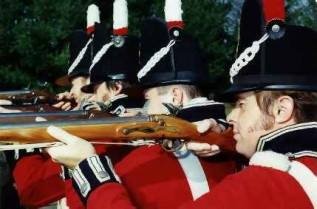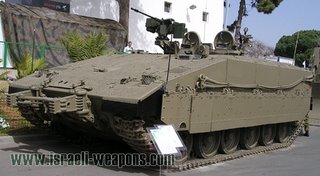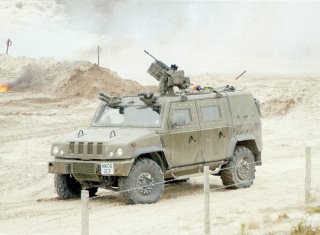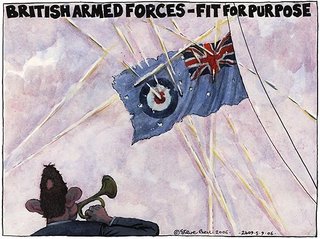 A crop of letters in the Telegraph today (double-click to enlarge), under the heading, "Armed Forces deaths are the result of a lack of equipment", attests to the fact that the this blog is by no means alone in its view of the MoD's procurement performance – not that we ever thought we were.
A crop of letters in the Telegraph today (double-click to enlarge), under the heading, "Armed Forces deaths are the result of a lack of equipment", attests to the fact that the this blog is by no means alone in its view of the MoD's procurement performance – not that we ever thought we were.But a recurrent theme in the debate is the issue of "underfunding". For instance, Telegraph correspondent James Heitz Jackson of London sees a direct correlation between the overstretch and underfunding imposed on our armed forces and the deaths of service personnel.
This is a charge made by former soldier Michael Moriarty in the "comment is free" section of the Guardian last week. Moriarty actually claims that soldiers are paying with their lives for the MoD’s incompetence, declaring that, "escalating commitments, budget squeezes and big equipment programmes have left Britain's forces fatally overstretched". He argues that:
Iraq and Afghanistan are stretching our forces - the army in particular - beyond the limits of the assumptions on which their funding is based. This situation has arisen through a combination of the government's enthusiasm for use of the armed forces to support its foreign-policy aims and the failure of defence chiefs to adequately highlight the limitations of military force and to demand that the government properly resource its military ambitions. There is a real risk that the armed forces could fail in their politically appointed tasks, with terrible long-term consequences for both them and Britain's world standing.
 This has had defence secretary Des Browne rushing to the ramparts with what he thinks is a rebuttal, denying that British troops are ill-equipped and that the defence budget is insufficient.
This has had defence secretary Des Browne rushing to the ramparts with what he thinks is a rebuttal, denying that British troops are ill-equipped and that the defence budget is insufficient.At the heart of Bowne's rebuttal is his claim that the Afghan operation is fully funded from the Special Reserve and, therefore, the defence budget is not threatened by operational costs. Furthermore, he claims, the annual defence budget has risen by five billion pounds over the last five years - well in excess of inflation.
One has to say that this sort of charge and counter-charge gets us nowhere. It is little more that the "yah-boo-sucks" type of exchange that you can get any day in any school playground, lacking as it does any detail upon which to chew.
 Actually, both are wrong and both are right – and neither has got to the key point. Yes, the defence budget has increased, and yes British forces are underfunded. And the reason both are right is that the money is going on useless projects like the Eurofighter, the Type 45 Destroyers and the Storm Shadow (the million pound bomb) – none of which are any use to the troops committed in either Iraq or Afghanistan.
Actually, both are wrong and both are right – and neither has got to the key point. Yes, the defence budget has increased, and yes British forces are underfunded. And the reason both are right is that the money is going on useless projects like the Eurofighter, the Type 45 Destroyers and the Storm Shadow (the million pound bomb) – none of which are any use to the troops committed in either Iraq or Afghanistan.But there is another all-important issue which neither of the proponents seem to have recognised. That is the value for money issue, which must also be assessed with regard to the tactical need.
Taking the second point first, outside a very narrow group of military specialists, there is very little debate as to what precisely is the right type and mix of equipment needed for counter-insurgency operations. Yet this issue is too important to be left to the specialists and – especially – the military establishment, which has a glorious and virtually unbroken record for getting it wrong.
 Whether it was the introduction of the rifle in the Napoleonic wars – which was strenuously resisted – the change from red tunics to khaki in the Boer War, and the tardy issue of machine guns, or failure to develop a suitable tank (or armoured personnel carrier) during the Second World War, the record is dismal.
Whether it was the introduction of the rifle in the Napoleonic wars – which was strenuously resisted – the change from red tunics to khaki in the Boer War, and the tardy issue of machine guns, or failure to develop a suitable tank (or armoured personnel carrier) during the Second World War, the record is dismal.One of the current, most vibrant arguments at the moment is the role of armour in counter-insurgency, one that came to the fore in the battle for Fallujah (see here and here), which has had the US military reappraising the role of Main Battle Tanks (MBTs) and committing to a major programme of upgrading their Abrams fleet to improve its survivability in urban warfare.
Similar thinking is influencing the Israeli military. Before the Lebanon war, it was a given that the IDF would halt production of the latest mark of its Merkava MBT.
 The view now – according to DefenseNews - is that the tank acquitted itself well in the recent fighting, not only in its primary role but in support missions such as escorting infantry, delivering supplies and even extracting battlefield casualties. The tank, therefore, is expected to evolve into a multi-purpose vehicle and its continued production looks assured.
The view now – according to DefenseNews - is that the tank acquitted itself well in the recent fighting, not only in its primary role but in support missions such as escorting infantry, delivering supplies and even extracting battlefield casualties. The tank, therefore, is expected to evolve into a multi-purpose vehicle and its continued production looks assured.Not only is the tank version undergoing a transformation, however, the Israelis are funding a project to develop the Merkava chassis into a dedicated armoured personnel carrier, called the Namera, building on their experiences with the Puma and its limitations.
All this is happening though at a time when the British Army is undergoing a major transformation, cutting back on its heavy armour and planning to replace much of its capability with medium-weight, wheeled armour, under the aegis of the £14 billion FRES programme, all to fit in with the EU concept of the European Rapid Reaction Force.
One can only marvel at the thought that the two armies which are most actively engaged at the sharp end with so-called "asymmetric warfare", in deadly counter-insurgency campaigns are opting for more and heavier armour while the British military establishment, imbued with the ethos of European integration, is going the other way.
 But, if the choice of equipment is suspect, what about the costs? One of the main disadvantages of the Israeli Namera, we are told, is the cost – at a cool $750,000 each. But that, in sterling, is £398,631 (at current exchange rates) yet this compares with £437,000 each for lightly armoured Pinzgauer trucks.
But, if the choice of equipment is suspect, what about the costs? One of the main disadvantages of the Israeli Namera, we are told, is the cost – at a cool $750,000 each. But that, in sterling, is £398,631 (at current exchange rates) yet this compares with £437,000 each for lightly armoured Pinzgauer trucks.No one is saying that the Namera would be the most appropriate equipment for the British Army in Afghanistan – although I suspect that some commanders would not turn them away if they were offered them – but surely the MoD can do better than spend nearly half a million for a truck that offers little if any better protection than that afforded by a "Snatch" Land Rover.
Then, as we have reported before, while there is a crying need for tactical helicopters in both Iraq and Afghanistan, the MoD is committed to buying the " future Lynx" at an average cost of £14.2 million each, which means that they cannot be brought into service until 2014. Yet, the US Army is quite content with the well-proven Kiowa variant, at less than £2.3 million each.
 All this and much more (such as the near £200 million on 400 useless Panthers – which cannot be used in Iraq - see also here) suggests that, not only is the MoD buying the wrong equipment, it is also paying far too much for what it does buy – the worst of all possible worlds. It also suggests that the problem is much more complex than the simple issue of "underfunding".
All this and much more (such as the near £200 million on 400 useless Panthers – which cannot be used in Iraq - see also here) suggests that, not only is the MoD buying the wrong equipment, it is also paying far too much for what it does buy – the worst of all possible worlds. It also suggests that the problem is much more complex than the simple issue of "underfunding".On the one hand, we have committed far too much on equipment that is of no use for the current campaigns and, on the other, much of what we do buy for the respective theatres is either overly expensive, under-performing or too late – or any combination of the three.
Echoing Booker's lament in his column last week: "Oh, for a properly clued-up media and an Opposition worthy of the name," we urgently need a properly informed debate both in Parliament and in the media.
 We have no great hopes of the former and, as for the latter, even if there were journalists around who were capable of understanding the issues, the likelihood is that they would not be allowed to write even half-way detailed stories (as we found to our cost here). Their editors, wedded to their dumbed-down diet of political soap operas and Diana-esq, human interest stories, can rise to the occasional cheap quickie - after the event – (or the occasional cartoon) but would judge detailed analyis too "boring" for their precious readers.
We have no great hopes of the former and, as for the latter, even if there were journalists around who were capable of understanding the issues, the likelihood is that they would not be allowed to write even half-way detailed stories (as we found to our cost here). Their editors, wedded to their dumbed-down diet of political soap operas and Diana-esq, human interest stories, can rise to the occasional cheap quickie - after the event – (or the occasional cartoon) but would judge detailed analyis too "boring" for their precious readers.Thus is the public condemned to ignorance and, as we keep pointing out, the consequences are all too evident. Ironically, during the early '80s, when the killer disease AIDS made its appearance, the Department of Health advertising slogan – to increase awareness – was "don't die of ignorance". Decades later, this looks to be the fate of many of our soldiers. The horrible reality, though, is that it will not be their ignorance which does for them – but ours.
COMMENT THREAD
No comments:
Post a Comment
Note: only a member of this blog may post a comment.